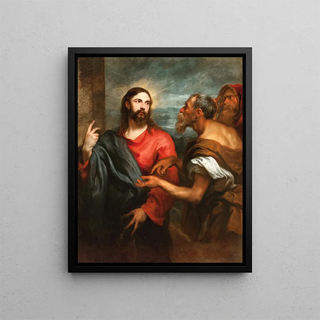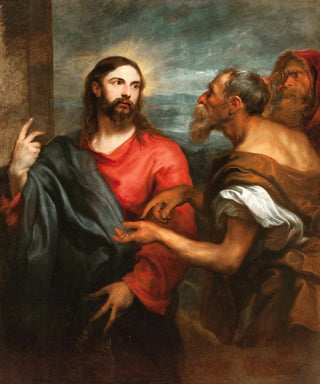Art print | The Christ of the Room - Antoine van Dyck


View from behind

Frame (optional)
Reproduction of The Christ of the scene - Antoine van Dyck – Captivating Introduction
Antoine van Dyck, Flemish master of the 17th century, masterfully captured the very essence of spirituality and human majesty through his works. Among his most iconic creations, "The Christ of the scene" stands out for its emotional depth and thoughtful composition. This piece, which transcends a simple religious portrait, invites the viewer to silent contemplation, an intimate encounter with the divine. The light, skillfully orchestrated, caresses the face of Christ, bestowing his figure with an aura of serenity and power. This artwork embodies the harmony between the sacred and the human, an timeless dialogue that still resonates today.
Style and uniqueness of the work
Van Dyck's style is characterized by a masterful use of color and light, giving his works an almost living dimension. In "The Christ of the scene," the interplay of shadows and light creates a sense of depth, where every detail is meticulously crafted. The drapery, flowing and delicate, reveals the artist's undeniable mastery in depicting textures. The chromatic palette, dominated by warm tones, evokes an atmosphere of reverence and intimacy. This piece does not merely illustrate a religious scene; it engages the viewer in a spiritual experience, where each gaze is lost in the eyes of Christ, witnesses to infinite suffering and compassion.
The artist and his influence
Antoine van Dyck, a pupil of Rubens, developed a personal style that left a mark on art history. His influence extends far beyond his era, impacting generations of artists. As a court portraitist, he redefined portrait painting standards, incorporating a psychological dimension into his representations. His innovative approach inspired masters such as Gainsborough and Sargent, who sought to capture not only appearance but also the soul of their subjects. Van Dyck also played a crucial role in spreading Flemish Baroque across Europe, transforming perceptions of light and color in art. "The Christ of

Matte finish

View from behind

Frame (optional)
Reproduction of The Christ of the scene - Antoine van Dyck – Captivating Introduction
Antoine van Dyck, Flemish master of the 17th century, masterfully captured the very essence of spirituality and human majesty through his works. Among his most iconic creations, "The Christ of the scene" stands out for its emotional depth and thoughtful composition. This piece, which transcends a simple religious portrait, invites the viewer to silent contemplation, an intimate encounter with the divine. The light, skillfully orchestrated, caresses the face of Christ, bestowing his figure with an aura of serenity and power. This artwork embodies the harmony between the sacred and the human, an timeless dialogue that still resonates today.
Style and uniqueness of the work
Van Dyck's style is characterized by a masterful use of color and light, giving his works an almost living dimension. In "The Christ of the scene," the interplay of shadows and light creates a sense of depth, where every detail is meticulously crafted. The drapery, flowing and delicate, reveals the artist's undeniable mastery in depicting textures. The chromatic palette, dominated by warm tones, evokes an atmosphere of reverence and intimacy. This piece does not merely illustrate a religious scene; it engages the viewer in a spiritual experience, where each gaze is lost in the eyes of Christ, witnesses to infinite suffering and compassion.
The artist and his influence
Antoine van Dyck, a pupil of Rubens, developed a personal style that left a mark on art history. His influence extends far beyond his era, impacting generations of artists. As a court portraitist, he redefined portrait painting standards, incorporating a psychological dimension into his representations. His innovative approach inspired masters such as Gainsborough and Sargent, who sought to capture not only appearance but also the soul of their subjects. Van Dyck also played a crucial role in spreading Flemish Baroque across Europe, transforming perceptions of light and color in art. "The Christ of






